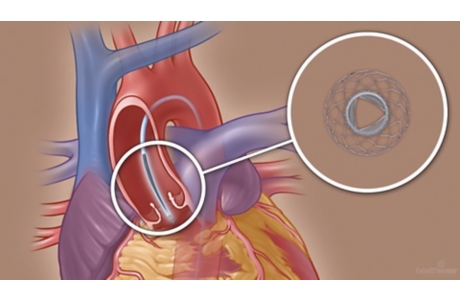Transcatheter Aortic Valve Replacement
Treatment Overview
Transcatheter aortic valve replacement (TAVR) is a way to replace the aortic valve without open-heart surgery. This procedure is done to treat aortic valve stenosis.
TAVR is often done through an incision (cut) in the groin. But sometimes a small cut is made in the chest. The doctor uses a tube called a catheter and tools that fit inside the catheter. The doctor puts the catheter into a blood vessel and moves it through the blood vessel and into the heart. The artificial valve fits inside the catheter. The doctor then moves the new valve into the damaged aortic valve. The artificial valve expands and takes the place of the damaged valve.
You may have general anesthesia, which makes you sleep during the surgery. Or you may get a sedative that will help you relax.
To see if TAVR might be a choice for you, a team of doctors will check many things about your heart and your overall health. Together you can decide if you want to have the procedure.
- TAVR may be a choice for you if you can’t have open-heart surgery because of other health conditions. You also may choose it if you have a high risk of serious problems from having surgery.
- Talk with your doctors about the possible benefits and risks for you.
- Also talk to your doctors about your goals for treatment. Your personal feelings are just as important as the medical facts in deciding whether to have TAVR.
What To Expect
You will probably stay in the hospital for a few days.
- While you are in the hospital, your doctors and nurses will watch you to check how the new valve is working.
- You will get information from the hospital about diet, activities, and medicine.
- You will need to have regular checkups with your doctor. When you leave the hospital, your doctor may give you a blood thinner medicine for a few months to prevent blood clots.
Be sure to tell all of your doctors and your dentist that you have an artificial aortic valve. This is important because you may need to take antibiotics before certain procedures to prevent an infection in your heart.
Why It Is Done
TAVR is done to treat narrowing (stenosis) of the aortic valve. This is the valve between your heart and the blood vessel (the aorta) that carries blood to your body. TAVR may also be done to replace an artificial aortic valve.
This procedure might be done for a person who can’t have surgery or who has a high risk of serious problems from surgery. For example, it might be an option if you are not healthy enough for open-heart surgery.footnote 1
How Well It Works
This procedure can help people who have aortic stenosis feel better and live longer.footnote 2
But how well this procedure works depends on several things, such as other health problems that a person has. These include other heart problems. Doctors are still learning who might benefit the most from TAVR.
Because TAVR is a newer treatment, doctors don’t yet know the long-term benefits or risks. They also don’t know how long the valves will last. But research shows that they work well for at least 5 years.footnote 3
Risks
TAVR doesn’t involve open-heart surgery. But the procedure does have serious risks. Some risks last just a short time. Others are long-term.
Risks include:
- Heart block. This is a problem with the electrical system in the heart. It can cause a slow heart rate. If this happens, a person may need a permanent pacemaker.
- Injury to the blood vessel used to put the catheter in the heart.
- Serious bleeding problems.
- Damage to the heart from the catheter.
- Heart attack.
- Stroke.
- Death.
References
Citations
- Otto CM, et al. (2017). 2017 ACC expert consensus decision pathway for transcatheter aortic valve replacement in the management of adults with aortic stenosis. Journal of the American College of Cardiology, 69(10): 1313–1346. DOI: 10.1016/j.jacc.2016.12.006. Accessed March 30, 2017.
- Kim CA, et al. (2014). Functional status and quality of life after transcatheter aortic valve replacement: A systematic review. Annals of Internal Medicine, 160(4): 243–254.
- Kapadia SR, et al. (2015). 5-year outcomes of transcatheter aortic valve replacement compared with standard treatment for patients with inoperable aortic stenosis (PARTNER1): A randomised controlled trial. Lancet. Published online March 15, 2015. DOI: http://dx.doi.org/10.1016/S0140-6736(15)60290-2. Accessed March 25, 2015.
Credits
Current as of: April 9, 2019
Author: Healthwise Staff
Medical Review:E. Gregory Thompson MD – Internal Medicine & Martin J. Gabica MD – Family Medicine & Kathleen Romito MD – Family Medicine & Elizabeth T. Russo MD – Internal Medicine & Adam Husney MD – Family Medicine & John A. McPherson MD, FACC, FSCAI – Cardiology
Current as of: April 9, 2019
Author: Healthwise Staff
Medical Review:E. Gregory Thompson MD – Internal Medicine & Martin J. Gabica MD – Family Medicine & Kathleen Romito MD – Family Medicine & Elizabeth T. Russo MD – Internal Medicine & Adam Husney MD – Family Medicine & John A. McPherson MD, FACC, FSCAI – Cardiology
This information does not replace the advice of a doctor. Healthwise, Incorporated, disclaims any warranty or liability for your use of this information. Your use of this information means that you agree to the Terms of Use. Learn how we develop our content.



